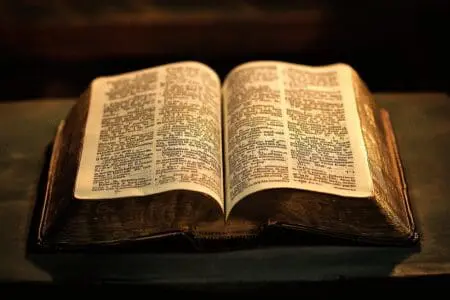Ever found yourself staring at a Bible on a shelf and just wondering? It’s a thick book. Impressive. And a simple question pops into your head: exactly how many pages are in the Bible? You’d think there would be a straightforward answer. There isn’t. Not even close. The real answer is a wild ride, swinging from a tidy 1,000 pages to a massive 2,500, or even more. The final number depends completely on the specific copy you’re holding.
Here’s the thing. The Bible isn’t one book. It’s a library. This collection of ancient writings, gathered over centuries, looks different depending on your tradition. On top of that, modern publishers make a thousand different choices that change the final page count. Everything from the translation you pick to the font size on the page plays a huge part in its thickness. So, while we can definitely explore the common numbers and the reasons behind them, the ultimate answer is always a shrug and a simple, “It depends.”
More in Bible Category
How Many Words Are in the KJV Bible
How Many Words Does the Bible Have
Key Takeaways
- There’s no single page count for the Bible; the number is all over the place.
- The biggest reason for the difference is the version. Protestant Bibles have 66 books, Catholic Bibles include 73, and Eastern Orthodox Bibles pack in even more.
- Publishing decisions are a huge factor. Font size, margins, paper thickness, and layout can drastically change the final count.
- Study Bibles are the giants of the group. They’re loaded with notes, maps, and guides that make them significantly longer than a standard Bible.
- As a rule of thumb, you can expect most standard Bibles to land somewhere between 1,200 and 1,800 pages.
So, Why Isn’t There One Standard Bible?
To get why the page count is so slippery, you have to understand that “The Bible” isn’t a single, straightforward book. It’s a collection. A compilation of totally distinct works—letters, sprawling histories, prophetic visions, and beautiful poetry—written by many different authors over a massive span of time. The huge task of deciding which books actually belonged in this sacred library is called “forming the canon.” This process took centuries, and different faith traditions came to different conclusions.
That divergence is the number one reason for the page-count chaos. Different faith communities honor different sets of books as God’s word. A Protestant can walk into a Christian bookstore and buy a Bible with a completely different table of contents than their Catholic or Orthodox friends. It’s a foundational difference in content, and it changes the length before a single publisher ever thinks about font size or layout.
What’s the Big Difference Between Canons?
The most important split happens between the Protestant, Catholic, and Eastern Orthodox churches. It all comes down to a group of writings known as the Apocrypha, or the Deuterocanonical books. These are important texts written in the fascinating period between the Old and New Testaments.
The Protestant Bible contains 66 books: 39 in the Old Testament and 27 in the New. This is the leanest of the major Christian canons.
The Catholic Bible, however, bumps that number up to 73 books. It has the same 66 books as the Protestant version, but it adds seven Deuterocanonical books to its Old Testament: Tobit, Judith, 1 and 2 Maccabees, the Wisdom of Solomon, Sirach, and Baruch. On top of that, it includes extra chapters for the books of Esther and Daniel. It makes sense, right? Adding seven whole books and more chapters will definitely increase the page count.
The Eastern Orthodox Bible contains even more. Its Old Testament comes from the Septuagint, a Greek translation of the Hebrew Scriptures that was popular when Jesus was alive. This version includes all the books the Catholic Bible adds, plus more, like 3 and 4 Maccabees, Psalm 151, and the Prayer of Manasseh. This makes the Orthodox Bible the longest of them all.
Does the Translation Actually Change the Page Count?
You bet it does. After you account for the number of books, the specific translation you’re reading is the next biggest thing affecting how many pages are in the Bible. Turning ancient Hebrew, Aramaic, and Greek into readable English is a massive undertaking. Scholars have different ideas about the best way to do it, and these philosophies change the final word count.
Some translations, like the classic King James Version (KJV) or the New American Standard Bible (NASB), are very literal. They use a “formal equivalence” or “word-for-word” approach. The goal is to match each original word as closely as possible, even keeping the old sentence structures. This can lead to longer, more complex sentences in English.
Then you have translations like the popular New International Version (NIV) or the New Living Translation (NLT). These use a “dynamic equivalence” or “thought-for-thought” method. Here, the goal is to capture the original meaning and feeling in natural, modern English. This often results in shorter, punchier sentences. While one method isn’t always longer in every single verse, these different styles really add up over a thousand-plus pages.
Can You Give Me Some Real-World Examples?
Let’s make this real. Here are a few popular English Bibles and their typical page counts. Keep in mind, these are just estimates for standard, text-only editions, but they show the differences clearly.
- King James Version (KJV): A typical KJV Bible usually hovers around 1,200 pages. Its beautiful, traditional language is beloved, but it can definitely use more words than modern translations.
- New International Version (NIV): As a bestseller, a standard NIV Bible often sits in the 1,100 to 1,400-page range. It really depends on the specific edition.
- English Standard Version (ESV): The ESV tries to be both literal and readable. It’s very similar to the NIV in length, usually falling between 1,100 and 1,300 pages.
- New American Bible, Revised Edition (NABRE): This is a go-to translation for Catholics. Because it includes the extra Deuterocanonical books, a standard edition is naturally longer, often pushing past 1,400 pages.
Remember, these are just ballpark figures. A publisher’s design choices can easily add or subtract a couple hundred pages from any of these.
Are All Bibles Printed the Same Way?
Not even close. The physical printing of the book is where the page count can really go wild. Think about it. A publisher can take the complete text of the NIV—one single text file with a fixed number of words—and use it to create dozens of Bibles, each with a totally different page count.
It’s just like any other book. A cheap paperback version of a novel will have way more pages than a big hardcover edition with tiny print. Bibles are the same, but the formatting options are even more extreme. Publishers design Bibles for literally every purpose you can imagine, from intense academic study to something you can toss in your purse. Each design changes the final size.
How Much Do Font Size and Layout Matter?
They matter more than anything else. This is the easiest factor to see for yourself. A large-print Bible, made for people who need bigger text, can easily stretch the same translation over 2,000 pages. But a compact “thinline” edition of that exact same Bible, designed for travel, might be only 1,100 pages. The words don’t change. The space they take up does.
The layout is another game-changer. Most Bibles use a traditional double-column format to pack more text onto each page. But more and more “reader’s Bibles” are being printed with a single column, just like a normal book. It feels more like reading a novel, but it also makes the Bible much thicker. Margins count, too. “Journaling Bibles” have huge, wide margins for writing notes, which adds a lot of pages.
What About All That Extra Stuff in My Bible?
Lots of Bibles are way more than just the biblical text. They’re complete reference tools, and all that bonus material adds some serious weight. These editions, called “study Bibles,” are usually the thickest Bibles you can buy.
A study Bible’s goal is to give you everything you need to understand the text on a deeper level. The actual scripture might only fill about 60% of each page. The rest is packed with commentary and notes. If you’ve ever seen a Bible that’s over 2,000 pages long, it’s almost certainly a study Bible. Some of the extras they pack in include:
- Tons of Footnotes and Commentary: Detailed notes at the bottom of the page that explain history, theology, and tricky translations.
- Book Introductions: Every book in the Bible gets its own multi-page introduction that covers the author, date, major themes, and a quick outline.
- A Concordance: This is a huge, alphabetized index of important words in the Bible and where to find them. A good concordance can be over 100 pages by itself.
- Cross-References: A web of notes that points you to other, related verses throughout the entire Bible.
- Maps, Charts, and Illustrations: Full-color maps of the ancient world, family trees, and diagrams of important places.
- Articles and Essays: Many study Bibles also include short articles on big topics like “How to Read the Bible” or “Christian Beliefs.”
Is There an “Average” Number of Pages I Can Expect?
Even with all this variation, we can still talk about a general average. If you grab a standard Protestant Bible (like a KJV, NIV, or ESV) that isn’t a massive study edition, you can bet it’s going to be somewhere in the 1,200 to 1,600-page range. For a standard Catholic Bible (like the NABRE) with its extra books, you’re probably looking at something closer to 1,400 to 1,800 pages.
Once you step into the world of study Bibles, that average goes through the roof. It’s totally normal for a study Bible loaded with features to be between 2,000 and 2,500 pages. All the extra material turns it from a book into a library. On the flip side, a small, portable New Testament might only be 400 pages.
How Does the Old Testament Compare to the New Testament?
Looking inside the Bible, there’s a huge size difference between the two main sections. The Old Testament is much, much longer than the New Testament. In most Bibles, the Old Testament takes up about 75% of the book, with the New Testament filling out the last 25%.
The reason is simple. The Old Testament covers a way longer period of history and has more books. It has the epic story of Israel’s beginnings, the detailed legal codes, the beautiful poetry of Psalms and Proverbs, and the writings of many prophets. The New Testament, in contrast, zooms in on the life of Jesus and the beginning of the Christian church over a much shorter time.
What if I Want to Read the Bible in a Year?
That big page count can look pretty scary if you want to read the whole Bible. But this is where breaking it down makes all the difference. Nearly all “Bible in a year” reading plans are designed to be totally achievable.
Think about it. For an average 1,200-page Bible, reading it in a year means you only have to read a little over three pages a day. That’s it. Many people find that’s surprisingly easy to fit into their day. The Bible’s structure helps, too. It’s already divided into 1,189 chapters (in Protestant Bibles), so a common plan is to just read three or four chapters a day. This shows how that intimidating total page count isn’t nearly as scary when you chop it into bite-sized pieces.
Are Digital Bibles a Different Story?
Oh, absolutely. In our digital world, the idea of a “page” is basically gone. When you use a Bible app on your phone or a website like Bible Gateway, you’re not turning pages. You’re just scrolling.
The whole game shifts. Instead of page numbers, you navigate using the Bible’s ancient reference system: book, chapter, and verse. It’s the universal standard. Digital Bibles are amazing. You can flip between translations in an instant, search for any word you want in seconds, and carry a whole library of study tools in your pocket. In this format, the physical length is meaningless. The King James Version still has the same number of words, but whether it would take 1,200 pages to print just doesn’t matter anymore.
So, How Should I Choose a Bible Then?
In the end, asking “how many pages in the Bible” is the wrong question if you’re trying to pick one out. The page count is just a side effect of other, much more important decisions. It tells you almost nothing about how good, readable, or useful that Bible will be for you.
Forget about the thickness of the book. Instead, ask about its purpose. What do you actually want to do with this Bible? Answering that one question will lead you to the perfect edition, no matter how many pages it has. When you’re ready to choose.
Focus on these things instead:
- Translation: This is number one. Find a translation you can actually understand and enjoy reading. Do you love the classic, poetic feel of the KJV, or do you prefer the clear, modern English of the NIV or NLT? Read some psalms or a story from Genesis in a few different versions before you buy.
- Faith Tradition: Make sure the Bible you get matches your faith community. If you’re Catholic, you’ll want a version that includes the Deuterocanonical books.
- Intended Use: How are you going to use it? If you want to do deep dives, get a feature-packed study Bible. If you need something to take to church or read on the train, a thin, compact edition is your best friend. If you just want to sit and read for hours, a single-column reader’s Bible is a dream.
- Physical Features: Don’t forget about the actual object. Is the font big enough for you to read comfortably? How does the paper feel? Super-thin “Bible paper” can let ink show through, but thicker paper makes for a heavier book. Finally, do you want a flexible leather cover or a tough hardcover?
The number of pages is just a statistic. It’s a consequence of content and design, not a measure of worth. The Bible’s real value isn’t found in its page count, but in the timeless words inside. Whether those words are spread across 1,000 pages or 2,500, their power to inspire, comfort, and challenge you is exactly the same.
Frequently Asked Questions – How Many Pages in the Bible

Does the translation style impact the page count of the Bible?
Yes, different translations like the KJV and NIV have slight variations in word count, which can lead to small differences in total page numbers, typically between 20 to 50 pages.
What should I consider when choosing a Bible based on pages and use?
When choosing a Bible, consider how you plan to use it, whether for carrying around, home reading, or study, and select an edition that fits your needs in size, text size, and additional features.
Does the physical format of the Bible influence the number of pages?
Yes, the physical format such as font size, line spacing, and paper thickness greatly affects the total number of pages, with larger fonts and thicker paper increasing the page count.
How do the books included in the Bible affect its length?
The number of books in a Bible significantly influences its length, with Catholic Bibles including seven additional books known as the deuterocanonical books, making them longer than Protestant Bibles.
Why is there no single page count for the Bible?
There is no single page count for the Bible because different editions include varying numbers of books and formatting choices, which all affect the total pages.




